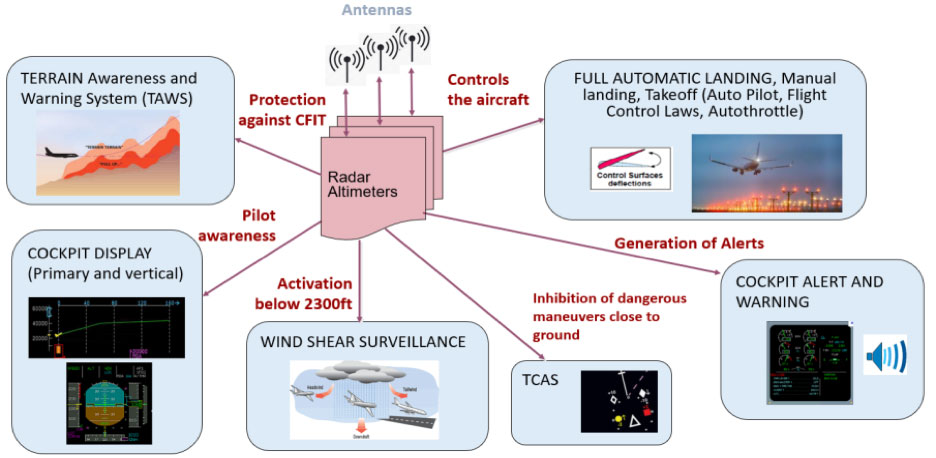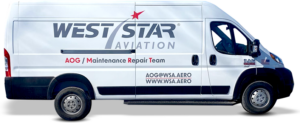

Many operators may still be confused about the current 5G rollout delay situation. That’s understandable. West Star Aviation’s Avionics Teams are following the current 5G rollout closely and wanted to try and clarify the situation and provide some insight you can really use.
Radar Altimeters and 5G Interference explained
Q – How might Terrestrial 5G Cellphone Towers affect Radar Altimetry in aircraft?
A – Interference
Interference in this situation could be caused by the Radar Altimeter Receiver Bandwidth being wide enough that new 5G transmission may affect the system operation.
As seen in this graphic below, new terrestrial 5G cellphone transmissions as licensed by the FCC operate between 3700 and 3980 Mhz. By FAA and International regulation aircraft Radar Altimeters operate between 4200 and 4400 Mhz.

The difference between the highest frequency allowed for 5G and the lowest frequency allowed for Radar Altimeters is a spread of 220 Mhz (4200 – 3980). In the radio world that is typically enough “dead Space” between the two to create enough separation where interference should not be an issue.
But as you will notice in the above diagram you can see that 5G drops off substantially in power at its allowed frequency bandwidth – Blue Area. Conversely though Radar Altimeter Transmitter bandwidth is restricted to 4200 – 4400 Mhz- Yellow Area, its receiver has a much wider spread to its receiver bandwidth to pick up signals – (indicated by green dotted line)
So how can this be, if allowable frequency is dictated to the above frequencies by FCC & FAA, how come Radar Altimeter receivers are allowed exceeds specification?
In this case, Radar Altimeters are built to what we call a TSO Specification, TSO-87a. This TSO was initially in 1966 and updated in 2012. The TSO sets the International Transmitter frequency to 4200 to 4400 Mhz. However, the TSO does not include any specific requirements regarding interference nor receiver Bandwidth. Back in 1966, 4200 – 4400 Mhz and its surrounding frequency space was vacant.
What is the solution?
Manufacturers of legacy and current production Radar Altimeter equipment are working on a Filter that when placed in-line with the Radar Altimeter antenna coax will limit the receiver to the specified 4200 – 4400 Mhz bandwidth. As of now this has not been approved by the FAA but expect a solution soon.
How Can Radar Altimeter Interference Cause Loss of Situational Awareness?
The radar altimeter plays a critical role in providing Situational Awareness by providing a displayed indication of height above terrain to the flight crew, they also form the basis of auditory altitude callouts during terminal landing procedures, as well as TCAS/ACAS and TAWS/EGPWS advisories and warnings.
Situational awareness of the flight crew is paramount to ensuring safe flight operations, especially flying in busy airspace, close to the ground, or in low visibility scenarios such as Instrument Meteorological Conditions (IMC). Erroneous or unexpected behavior of the radar altimeter directly leads to a loss of situational awareness for the flight crew. Not only does this loss of situational awareness present an immediate impact to the ability of the flight crew to maintain safe operation of the aircraft, it also requires the flight crew to attempt to compensate for the lack of reliable height above ground information using other sensors and visual cues, if available. This further leads to a risk of task saturation for the flight crew, particularly during operations or phases of flight which require continuous crew engagement, such as final approach and landing procedures.

If you have any questions regarding 5G rollout and its effect on aviation, please contact one of the West Star Avionics Specialists below:

Aaron Berg
Technical Sales Manager
, Avionics (GJT)
Office 970.243.7500
aberg@wsa.aero

Jim Ellis
Technical Sales Manager, Avionics (ALN)
Office 618.258.8065
jellis@wsa.aero

Josh Peterson
Technical Sales Manager,
Avionics (CHA)
Office 423.661.8928
jpeterson@wsa.aero

Walt Marcy
Technical Sales Manager
, Avionics (GJT)
Office 970.248.5258
wmarcy@wsa.aero

Mike Sichmeller
Technical Sales Manager
, Avionics (ALN)
Office 618.258.8863
msichmeller@wsa.aero

Jeff Messmer
Technical Sales Manager
(PCD)
Cell 314.607.4069
jmessmer@wsa.aero
- Posted in Avionics Tips, News
- No Comments


















